Using the IL-TEM Technique to Understand the Mechanism and Improve the Durability of Platinum Cathode Catalysts for Proton-Exchange Membrane Fuel Cells
Abstract
:1. Introduction
2. Importance of PEMFCs for Enabling Low-Carbon Transport
3. Nanostructured Carbon Materials as Pt Support in Fuel Cells
4. Importance of Durability of Pt on Carbon Support
- The migration and agglomeration of Pt catalyst particles on the carbon support, which are the result of their nanometric size and the resulting high surface energy of the particles.
- The dissolution of small Pt particles at high potential and their tendency to settle on larger Pt particles at low potential (Ostwald mechanism), which are caused by the difference in surface energy resulting from the inhomogeneity of the Pt particle size [50].
- The corrosion of the carbon support as a result of a momentary high potential arising during start/stop or lack-of-fuel conditions, which causes the detachment (falling off) of Pt particles [45].
5. Investigation Methods of Catalyst Degradation Mechanisms
6. Identical-Location Transmission Electron Microscopy (IL-TEM) Method
- -
- Whether the modification of the structure of the carbon support affects the degradation mechanism;
- -
- Whether Pt dissolution plays an important role in catalyst deactivation under specific conditions and correlates qualitatively with electrochemical measurements;
- -
- Whether the minimization of surface energy during electrochemical activation affects the nanoparticle structure.
7. Summary
- -
- The establishment of a quantitative correlation with electrochemical measurements, primarily ESCA loss;
- -
- The extension of the scope of observations made (other types of catalysts, other types of supports, other types of electrolytes, a wider range of potential changes, higher temperatures, other gas atmospheres, …);
- -
- IL-TEM tests performed in PEMFCs under real operating conditions;
- -
- The combination with other techniques (electrochemical and, e.g., X-ray imaging, …).
Author Contributions
Funding
Data Availability Statement
Conflicts of Interest
References
- Schlögl, K.; Hanzlik, M.; Arenz, M. Comparative IL-TEM study concerning the degradation of carbon supported Pt-based electrocatalysts. J. Electrochem. Soc. 2012, 159, B677–B682. [Google Scholar] [CrossRef]
- Hengge, K.; Gänsler, T.; Pizzutilo, E.; Heinzl, C.; Beetz, M.; Mayrhofer, K.J.J.; Scheu, C. Accelerated fuel cell tests of anodic Pt/Ru catalyst via identical location TEM: New aspects of degradation behavior. Int. J. Hydrogen Energy 2017, 42, 25359–25371. [Google Scholar] [CrossRef]
- Bijelić, L.; Ruiz-Zepeda, F.; Hodnik, N. The role of high-resolution transmission electron microscopy and aberration corrected scanning transmission electron microscopy in unraveling the structure-property relationships of Pt-based fuel cells electrocatalysts. Inorg. Chem. Front. 2024, 11, 323–341. [Google Scholar] [CrossRef]
- Perez-Alonso, F.J.; Elkjær, C.F.; Shim, S.S.; Abrams, B.L.; Stephens, I.E.L.; Chorkendorff, I. Identical locations transmission electron microscopy study of Pt/C electrocatalyst degradation during oxygen reduction reaction. J. Power Sources 2011, 196, 6085–6091. [Google Scholar] [CrossRef]
- Kwag, J.; Kim, S.; Kang, S.; Park, J. Multiple-length scale investigation of Pt/C degradation by identical-location transmission electron microscopy. Bull. Korean Chem. Soc. 2023, 44, 488–494. [Google Scholar] [CrossRef]
- Rasouli, S.; Ferreira, P.J. Understanding the stability of nanoscale catalysts in PEM Fuel cells by identical location TEM. In Nanocarbons for Energy Conversion: Supramolecular Approaches; Nakashima, N., Ed.; Springer: Cham, Switzerland, 2019; pp. 119–134. [Google Scholar]
- Meier, J.C.; Galeano, C.; Katsounaros, I.; Topalov, A.A.; Kostka, A.; Schüth, F.; Mayrhofer, K.J. Degradation mechanisms of Pt/C fuel cell catalysts under simulated start–stop conditions. ACS Catal. 2012, 2, 832–843. [Google Scholar] [CrossRef]
- Mayrhofer, K.J.; Meier, J.C.; Ashton, S.J.; Wiberg, G.K.; Kraus, F.; Hanzlik, M.; Arenz, M. Fuel cell catalyst degradation on the nanoscale. Electrochem. Commun. 2008, 10, 1144–1147. [Google Scholar] [CrossRef]
- Yu, K.; Li, C.; Xie, J.; Ferreira, P.J. Understanding the Degradation Mechanisms of Pt Electrocatalysts in PEMFCs by Combining 2D and 3D Identical Location TEM. Nano Lett. 2023, 23, 1858–1864. [Google Scholar] [CrossRef] [PubMed]
- Debe, M.K. Electrocatalyst approaches and challenges for automotive fuel cells. Nature 2012, 486, 43–51. [Google Scholar] [CrossRef]
- Wang, W.; Lei, B.; Guo, S. Engineering multimetallic nanocrystals for highly efficient oxygen reduction catalysts. Adv. Energy Mater. 2016, 6, 1600236. [Google Scholar] [CrossRef]
- Cano, Z.P.; Banham, D.; Ye, S.; Hintennach, A.; Lu, J.; Fowler, M.; Chen, Z. Batteries and fuel cells for emerging electric vehicle markets. Nat. Energy 2018, 3, 279–289. [Google Scholar] [CrossRef]
- Yoshida, T.; Kojima, K. Toyota MIRAI fuel cell vehicle and progress toward a future hydrogen society. Electrochem. Soc. Interface 2015, 24, 45–49. [Google Scholar] [CrossRef]
- Wang, Y.; Diaz, D.F.R.; Chen, K.S.; Wang, Z.; Adroher, X.C. Materials, technological status, and fundamentals of PEM fuel cells–a review. Mater. Today 2020, 32, 178–203. [Google Scholar] [CrossRef]
- Reverdiau, G.; Le Duigou, A.; Alleau, T.; Aribart, T.; Dugast, C.; Priem, T. Will there be enough platinum for a large deployment of fuel cell electric vehicles? Int. J. Hydrogen Energy 2021, 46, 39195–39207. [Google Scholar] [CrossRef]
- Wilson, M.S.; Gottesfeld, S. Thin-film catalyst layers for polymer electrolyte fuel cell electrodes. J. Appl. Electrochem. 1992, 22, 1–7. [Google Scholar] [CrossRef]
- Carmo, M.; Dos Santos, A.R.; Poco, J.G.R.; Linardi, M. Physical and electrochemical evaluation of commercial carbon black as electrocatalysts supports for DMFC applications. J. Power Sources 2007, 173, 860–866. [Google Scholar] [CrossRef]
- Antolini, E. Carbon supports for low-temperature fuel cell catalysts. Appl. Catal. B Environ. 2009, 88, 1–24. [Google Scholar] [CrossRef]
- Kaye, G. Structural changes in heat treated carbon blacks. Carbon 1965, 2, 413–419. [Google Scholar] [CrossRef]
- Su, D.S.; Zhang, B.; Schlögl, R. Electron Microscopy of Solid Catalysts—Transforming from a Challenge to a Toolbox. Chem. Rev. 2015, 115, 2818–2882. [Google Scholar] [CrossRef] [PubMed]
- Yoshizawa, N.; Tanaike, O.; Hatori, H.; Yoshikawa, K.; Kondo, A.; Abe, T. TEM and electron tomography studies of carbon nanospheres for lithium secondary batteries. Carbon 2006, 44, 2558–2564. [Google Scholar] [CrossRef]
- Yoshizawa, N.; Hatori, H.; Yoshikawa, K.; Miura, K.; Abe, T. TEM observation of heterogeneous polyhedronization behavior in graphitized carbon nanospheres. Mater. Sci. Eng. B 2008, 148, 245–248. [Google Scholar] [CrossRef]
- Pawlyta, M.; Rouzaud, J.N.; Duber, S. Raman microspectroscopy characterization of carbon blacks: Spectral analysis and structural information. Carbon 2015, 84, 479–490. [Google Scholar] [CrossRef]
- Coloma, F.; Sepulveda-Escribano, A.; Fierro, J.L.G.; Rodriguez-Reinoso, F. Preparation of platinum supported on pregraphitized carbon blacks. Langmuir 1994, 10, 750–755. [Google Scholar] [CrossRef]
- Coloma, F.; Sepulveda-Escribano, A.; Rodriguez-Reinoso, F. Heat-treated carbon-blacks as supports for platinum catalysts. J. Catal. 1995, 154, 299–305. [Google Scholar] [CrossRef]
- Liu, H.; Li, J.; Xu, X.; Wang, F.; Liu, J.; Li, Z.; Ji, J. Highly graphitic carbon black-supported platinum nanoparticle catalyst and its enhanced electrocatalytic activity for the oxygen reduction reaction in acidic medium. Electrochim. Acta 2013, 93, 25–31. [Google Scholar] [CrossRef]
- Hara, M.; Lee, M.; Liu, C.H.; Chen, B.H.; Yamashita, Y.; Uchida, M.; Watanabe, M. Electrochemical and Raman spectroscopic evaluation of Pt/graphitized carbon black catalyst durability for the start/stop operating condition of polymer electrolyte fuel cells. Electrochim. Acta 2012, 70, 171–181. [Google Scholar] [CrossRef]
- Sui, S.; Wang, X.; Zhou, X.; Su, Y.; Riffat, S.; Liu, C.J. A comprehensive review of Pt electrocatalysts for the oxygen reduction reaction: Nanostructure, activity, mechanism and carbon support in PEM fuel cells. J. Mater. Chem. A 2017, 5, 1808–1825. [Google Scholar] [CrossRef]
- Wang, Y.J.; Fang, B.; Li, H.; Bi, X.T.; Wang, H. Progress in modified carbon support materials for Pt and Pt-alloy cathode catalysts in polymer electrolyte membrane fuel cells. Prog. Mater. Sci. 2016, 82, 445–498. [Google Scholar] [CrossRef]
- Samad, S.; Loh, K.S.; Wong, W.Y.; Lee, T.K.; Sunarso, J.; Chong, S.T.; Daud, W.R.W. Carbon and non-carbon support materials for platinum-based catalysts in fuel cells. Int. J. Hydrogen Energy 2018, 43, 7823–7854. [Google Scholar] [CrossRef]
- Hu, X.; Yang, B.; Ke, S.; Liu, Y.; Fang, M.; Huang, Z.; Min, X. Review and perspectives of carbon-supported platinum-based catalysts for proton exchange membrane fuel cells. Energy Fuels 2023, 37, 11532–11566. [Google Scholar] [CrossRef]
- Qiao, Z.; Wang, C.; Zeng, Y.; Spendelow, J.S.; Wu, G. Advanced nanocarbons for enhanced performance and durability of platinum catalysts in proton exchange membrane fuel cells. Small 2021, 17, 2006805. [Google Scholar] [CrossRef]
- Shao, Y.; Liu, J.; Wang, Y.; Lin, Y. Novel catalyst support materials for PEM fuel cells: Current status and future prospects. J. Mater. Chem. 2009, 19, 46–59. [Google Scholar] [CrossRef]
- Shao, Y.; Yin, G.; Wang, J.; Gao, Y.; Shi, P. Multi-walled carbon nanotubes based Pt electrodes prepared with in situ ion exchange method for oxygen reduction. J. Power Sources 2006, 161, 47–53. [Google Scholar] [CrossRef]
- Machado, B.F.; Serp, P. Graphene-based materials for catalysis. Catal. Sci. Technol. 2012, 2, 54–75. [Google Scholar] [CrossRef]
- Yoo, E.; Okata, T.; Akita, T.; Kohyama, M.; Nakamura, J.; Honma, I. Enhanced electrocatalytic activity of Pt subnanoclusters on graphene nanosheet surface. Nano Lett. 2009, 9, 2255–2259. [Google Scholar] [CrossRef]
- Kou, R.; Shao, Y.; Wang, D.; Engelhard, M.H.; Kwak, J.H.; Wang, J.; Liu, J. Enhanced activity and stability of Pt catalysts on functionalized graphene sheets for electrocatalytic oxygen reduction. Electrochem. Commun. 2009, 11, 954–957. [Google Scholar] [CrossRef]
- Jaimes-Paez, C.D.; Vences-Alvarez, E.; Salinas-Torres, D.; Morallón, E.; Rangel-Mendez, J.R.; Cazorla-Amorós, D. Microwave-assisted synthesis of carbon-supported Pt nanoparticles for their use as electrocatalysts in the oxygen reduction reaction and hydrogen evolution reaction. Electrochim. Acta 2023, 464, 142871. [Google Scholar] [CrossRef]
- Ma, J.; Habrioux, A.; Luo, Y.; Ramos-Sanchez, G.; Calvillo, L.; Granozzi, G.; Alonso-Vante, N. Electronic interaction between platinum nanoparticles and nitrogen-doped reduced graphene oxide: Effect on the oxygen reduction reaction. J. Mater. Chem. A 2015, 3, 11891–11904. [Google Scholar] [CrossRef]
- Olabi, A.G.; Wilberforce, T.; Abdelkareem, M.A. Fuel cell application in the automotive industry and future perspective. Energy 2021, 214, 118955. [Google Scholar] [CrossRef]
- Cullen, D.A.; Neyerlin, K.C.; Ahluwalia, R.K.; Mukundan, R.; More, K.L.; Borup, R.L.; Kusoglu, A. New roads and challenges for fuel cells in heavy-duty transportation. Nat. Energy 2021, 6, 462–474. [Google Scholar] [CrossRef]
- Luo, Y.; Wu, Y.; Li, B.; Mo, T.; Li, Y.; Feng, S.P.; Chu, P.K. Development and application of fuel cells in the automobile industry. J. Energy Storage 2021, 42, 103124. [Google Scholar] [CrossRef]
- Topalov, A.A.; Cherevko, S.; Zeradjanin, A.R.; Meier, J.C.; Katsounaros, I.; Mayrhofer, K.J.J. Towards a comprehensive understanding of platinum dissolution in acidic media. Chem. Sci. 2014, 5, 631–638. [Google Scholar] [CrossRef]
- Cherevko, S.; Keeley, G.P.; Geiger, S.; Zeradjanin, A.R.; Hodnik, N.; Kulyk, N.; Mayrhofer, K.J.J. Dissolution of platinum in the operational range of fuel cells. ChemElectroChem 2015, 2, 1471–1478. [Google Scholar] [CrossRef] [PubMed]
- Meier, J.C.; Galeano, C.; Katsounaros, I.; Witte, J.; Bongard, H.J.; Topalov, A.A.; Baldizzone, C.; Mezzavilla, S.; Schuth, F.; Mayrhofer, K.J.J. Design criteria for stable Pt/C fuel cell catalysts. Beilstein J. Nanotechnol. 2014, 5, 44–67. [Google Scholar] [CrossRef] [PubMed]
- Yasuda, K.; Taniguchi, A.; Akita, T.; Ioroi, T.; Siroma, Z. Platinum dissolution and deposition in the polymer electrolyte membrane of a PEM fuel cell as studied by potential cycling. Phys. Chem. Chem. Phys. 2006, 8, 746–752. [Google Scholar] [CrossRef] [PubMed]
- Challa, S.R.; Delariva, A.T.; Hansen, T.W.; Helveg, S.; Sehested, J.; Hansen, P.L.; Garzon, F.; Datye, A.K. Relating rates of catalyst sintering to the disappearance of individual nanoparticles during Ostwald ripening. J. Am. Chem. Soc. 2011, 133, 20672–20675. [Google Scholar] [CrossRef] [PubMed]
- Okonkwo, P.C.; Ige, O.O.; Uzoma, P.C.; Emori, W.; Benamor, A.; Abdullah, A.M. Platinum degradation mechanisms in proton exchange membrane fuel cell (PEMFC) system: A review. Int. J. Hydrogen Energy 2021, 46, 15850–15865. [Google Scholar] [CrossRef]
- Xie, M.; Chu, T.; Wang, X.; Li, B.; Yang, D.; Ming, P.; Zhang, C. Effect of mesoporous carbon on oxygen reduction reaction activity as cathode catalyst support for proton exchange membrane fuel cell. Int. J. Hydrogen Energy 2022, 47, 28074–28085. [Google Scholar] [CrossRef]
- Cherevko, S.; Kulyk, N.; Mayrhofer, K.J.J. Durability of platinum based fuel cell electrocatalysts: Dissolution of bulk and nanoscale platinum. Nano Energy 2016, 29, 275–298. [Google Scholar] [CrossRef]
- Xie, X.; Chen, S.G.; Ding, W.; Nie, Y.; Wei, Z.D. An extraordinarily stable catalyst: Pt NPs supported on two-dimensional Ti3C2X2 (X = OH, F) nanosheets for oxygen reduction reaction. Chem. Commun. 2013, 86, 10112–10114. [Google Scholar] [CrossRef]
- Zhu, B.; Mi, Y.; Xia, C.; Wang, B.; Kim, J.S.; Lund, P.; Li, T. A nanoscale perspective on solid oxide and semiconductor membrane fuel cells: Materials and technology. Energy Mater 2021, 1, 1000002. [Google Scholar] [CrossRef]
- Borup, R.; Meyers, J.; Pivovar, B.; Kim, Y.S.; Mukundan, R.; Garland, N.; Myers, D.; Wilson, M.; Garzon, F.; Wood, D.; et al. Scientific aspects of polymer electrolyte fuel cell durability and degradation. Chem. Rev. 2007, 107, 3904–3951. [Google Scholar] [CrossRef]
- Padgett, E.; Yarlagadda, V.; Holtz, M.E.; Ko, M.; Levin, B.D.A.; Kukreja, R.S.; Ziegelbauer, J.M.; Andrews, R.N.; Ilavsky, J.; Kongkanand, A.; et al. Mitigation of PEM fuel cell catalyst degradation with porous carbon supports. J. Electrochem. Soc. 2019, 166, F198–F207. [Google Scholar] [CrossRef]
- Xie, J.; Wood, D.L.; Wayne, D.M.; Zawodzinski, T.A.; Atanassov, P.; Borup, R.L. Durability of PEFCs at high humidity conditions. J. Electrochem. Soc. 2004, 152, A104. [Google Scholar] [CrossRef]
- Borup, R.; Davey, J.; Garzon, F.; Wood, D.; Welch, P.; More, K. PEM fuel cell durability with transportation transient operation. ECS Trans. 2006, 3, 879. [Google Scholar] [CrossRef]
- Shao, Y.; Yin, G.; Gao, Y. Understanding and approaches for the durability issues of Pt-based catalysts for PEM fuel cell. J. Power Sources 2007, 171, 558–566. [Google Scholar] [CrossRef]
- Arico, A.S.; Stassi, A.; Modica, E.; Ornelas, R.; Gatto, I.; Passalacqua, E.; Antonucci, V. Evaluation of high temperature degradation of Pt/C Catalysts in PEM fuel cells. ECS Trans. 2006, 3, 765. [Google Scholar] [CrossRef]
- Zhang, Y.; Chen, S.; Wang, Y.; Ding, W.; Wu, R.; Li, L.; Qi, X.; Wei, Z. Study of the degradation mechanisms of carbon-supported platinum fuel cells catalyst via different accelerated stress test. J. Power Sources 2015, 273, 62–69. [Google Scholar] [CrossRef]
- Martens, S.; Asen, L.; Ercolano, G.; Dionigi, F.; Zalitis, C.; Hawkins, A.; Bonastre, A.M.; Seidl, L.; Knoll, A.C.; Sharman, J.; et al. A comparison of rotating disc electrode, floating electrode technique and membrane electrode assembly measurements for catalyst testing. J Power Sources 2018, 392, 274–284. [Google Scholar] [CrossRef]
- Xue, Q.; Yang, D.; Jiang, L.; Li, B.; Ming, P. Modifying Carbon Supports of Catalyst for the Oxygen Reduction Reaction in Vehicle PEMFCs. Automot. Innov. 2021, 4, 119–130. [Google Scholar] [CrossRef]
- Perego, A.; Avid, A.; Mamania, D.N.; Chen, Y.; Atanassov, P.; Yildirim, H.; Odgaard, M.; Zenyuk, I.V. Investigation of cathode catalyst layer interfaces evolution during accelerated stress tests for polymer electrolyte fuel cells. Appl. Catal. B Environ. 2022, 301, 120810. [Google Scholar] [CrossRef]
- Xia, Y.F.; Guo, P.; Li, J.Z.; Zhao, L.; Sui, X.L.; Wang, Y.; Wang, Z.B. How to appropriately assess the oxygen reduction reaction activity of platinum group metal catalysts with rotating disk electrode. iScience 2021, 24, 103024. [Google Scholar] [CrossRef]
- Ohma, A.; Shinohara, K.; Iiyama, A.; Yoshida, T.; Daimaru, A. Membrane and catalyst performance targets for automotive fuel cells by FCCJ membrane, catalyst, MEA WG. ECS Trans. 2011, 41, 775. [Google Scholar] [CrossRef]
- Arenz, M.; Zana, A. Fuel cell catalyst degradation: Identical location electron microscopy and related methods. Nano Energy 2016, 29, 299–313. [Google Scholar] [CrossRef]
- U.S. Department of Energy. Accelerated Stress Test and Polarization Curve Protocols for PEM Fuel Cells. 2013. Available online: https://www.energy.gov/eere/fuelcells/downloads/fuel-celltech-team-accelerated-stress-test-and-polarization-curve (accessed on 16 February 2024).
- Patil, V.; Reshmi, P.V.; Prajna, S.; Haleshappa, D.; Jayarama, A.; Pinto, R. Degradation mechanisms in PEM fuel cells: A brief review. In Materials Today: Proceedings; Elsevier: Amsterdam, The Netherlands, 2023. [Google Scholar] [CrossRef]
- Kang, L.; Xu, R.; Yan, J.H.C.; Cacho-Nerin, F.; Parker, J.E.; Allen, C.S.; Wang, F.R. Quantification and visualisation statistics of Pt cathode degradation via correlative electron and X-ray imaging. ChemRxiv 2023. [Google Scholar] [CrossRef]
- Mayrhofer, K.J.; Ashton, S.J.; Meier, J.C.; Wiberg, G.K.; Hanzlik, M.; Arenz, M. Non-destructive transmission electron microscopy study of catalyst degradation under electrochemical treatment. J. Power Sources 2008, 185, 734–739. [Google Scholar] [CrossRef]
- Hartl, K.; Hanzlik, M.; Arenz, M. IL-TEM investigations on the degradation mechanism of Pt/C electrocatalysts with different carbon supports. Energy Environ. Sci. 2011, 4, 234–238. [Google Scholar] [CrossRef]
- Hrnjic, A.; Kamšek, A.R.; Pavlišič, A.; Šala, M.; Bele, M.; Moriau, L.; Gatalo, M.; Ruiz-Zepeda, F.; Jovanovič, P.; Hodnik, N. Observing, tracking and analysing electrochemically induced atomic-scale structural changes of an individual Pt-Co nanoparticle as a fuel cell electrocatalyst by combining modified floating electrode and identical location electron microscopy. Electrochim. Acta 2021, 388, 138513. [Google Scholar] [CrossRef]
- Pawlyta, M.; Smykała, S.; Liszka, B.; Blacha-Grzechnik, A. Transmission Electron Microscopy Observation of the Fuel Cell Catalyst Degradation during the Oxygen Reduction Reaction. Defect Diffus. Forum 2022, 420, 91–100. [Google Scholar] [CrossRef]
- Shokhen, V.; Strandberg, L.; Skoglundh, M.; Wickman, B. Fuel cell electrode degradation followed by identical location transmission electron microscopy. J. Mater. Chem. A 2023, 11, 21029–21035. [Google Scholar] [CrossRef]
- Macauley, N.; Papadias, D.D.; Fairweather, J.; Spernjak, D.; Langlois, D.; Ahluwalia, R.; Borup, R.L. Carbon corrosion in PEM fuel cells and the development of accelerated stress tests. J. Electrochem. Soc. 2018, 165, F3148–F3160. [Google Scholar] [CrossRef]
- Yu, H.; Zachman, M.J.; Li, C.; Hu, L.; Kariuki, N.N.; Mukundan, R.; Xie, J.; Neyerlin, K.C.; Myers, D.J.; Cullen, D.A. Recreating Fuel Cell Catalyst Degradation in Aqueous Environments for Identical-Location Scanning Transmission Electron Microscopy Studies. ACS Appl. Mater. Interfaces 2022, 14, 20418–20429. [Google Scholar] [CrossRef] [PubMed]
- Nikkuni, F.R.; Vion-Dury, B.; Dubau, L.; Maillard, F.; Ticianelli, E.A.; Chatenet, M. The role of water in the degradation of Pt3Co/C nanoparticles: An Identical Location Transmission Electron Microscopy study in polymer electrolyte environment. Appl. Catal. B Environ. 2014, 156, 301–306. [Google Scholar] [CrossRef]
- Schlögl, K.; Mayrhofer, K.J.; Hanzlik, M.; Arenz, M. Identical-location TEM investigations of Pt/C electrocatalyst degradation at elevated temperatures. J. Electroanal. Chem. 2011, 662, 355–360. [Google Scholar] [CrossRef]
- Zana, A.; Speder, J.; Roefzaad, M.; Altmann, L.; Bäumer, M.; Arenz, M. Probing degradation by IL-TEM: The influence of stress test conditions on the degradation mechanism. J. Electrochem. Soc. 2013, 160, F608. [Google Scholar] [CrossRef]
- Dubau, L.; Castanheira, L.; Berthomé, G.; Maillard, F. An identical-location transmission electron microscopy study on the degradation of Pt/C nanoparticles under oxidizing, reducing and neutral atmosphere. Electrochim. Acta 2013, 110, 273–281. [Google Scholar] [CrossRef]
- Speder, J.; Zana, A.; Spanos, I.; Kirkensgaard, J.J.; Mortensen, K.; Hanzlik, M.; Arenz, M. Comparative degradation study of carbon supported proton exchange membrane fuel cell electrocatalysts–The influence of the platinum to carbon ratio on the degradation rate. J. Power Sources 2014, 261, 14–22. [Google Scholar] [CrossRef]
- Paciok, P.; Schalenbach, M.; Carmo, M.; Stolten, D. On the mobility of carbon-supported platinum nanoparticles towards unveiling cathode degradation in water electrolysis. J. Power Sources 2017, 365, 53–60. [Google Scholar] [CrossRef]
- Souza, N.E.; Bott-Neto, J.L.; Rocha, T.A.; da Silva, G.C.; Teixeira-Neto, E.; Gonzalez, E.R.; Ticianelli, E.A. Support modification in Pt/C electrocatalysts for durability increase: A degradation study assisted by identical location transmission electron microscopy. Electrochim. Acta 2018, 265, 523–531. [Google Scholar] [CrossRef]
- Miyabayashi, K.; Shirayama, Y.; Surabhi, G.; Tatsuoka, H. Identical-location Transmission Electron Microscopy of Pt Nanoparticle Electrocatalysts Using Iridium-coated Au Grids for Fuel Cell Durability Tests Simulating Start-up and Shutdown Conditions. Electroanalysis 2023, 35, e202200199. [Google Scholar] [CrossRef]
- Rasouli, S.; Myers, D.; Higashida, K.; Nakashima, N.; Crozier, P.; Ferreira, P. Electrochemical Evolution of Fuel Cell Platinum Nanocatalysts on Carbon Nanotubes at the Atomic Scale. ACS Appl. Energy Mater. 2023, 6, 11861–11873. [Google Scholar] [CrossRef]
- Catalyst, F.C. Stability of commercial Pt/C low temperature fuel cell catalyst: Electrochemical IL-SEM study. Acta Chim. Slov. 2014, 61, 280–283. [Google Scholar]
- Hodnik, N.; Zorko, M.; Jozinović, B.; Bele, M.; Dražič, G.; Hočevar, S.; Gaberšček, M. Severe accelerated degradation of PEMFC platinum catalyst: A thin film IL-SEM study. Electrochem. Commun. 2013, 30, 75–78. [Google Scholar] [CrossRef]

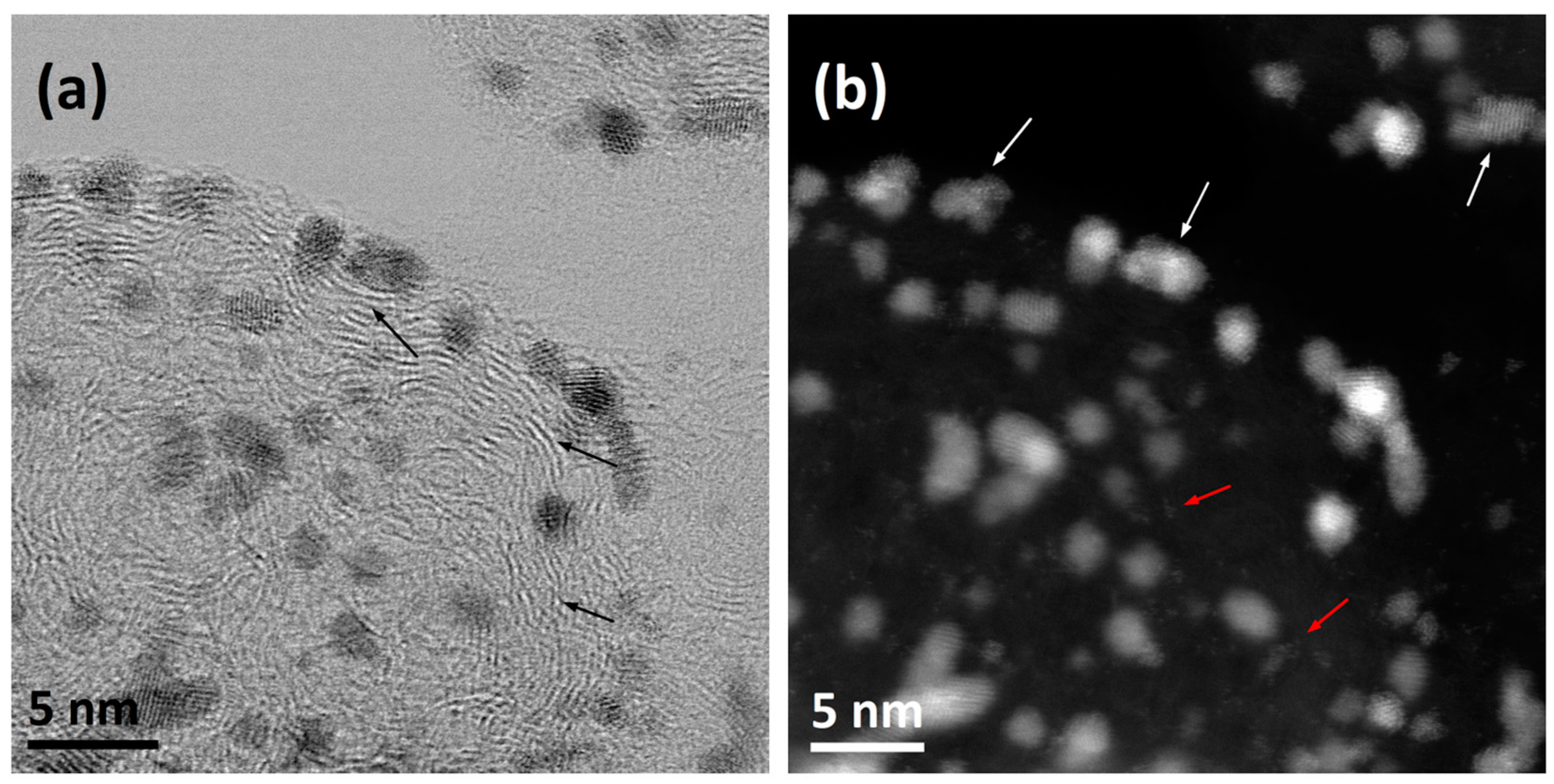
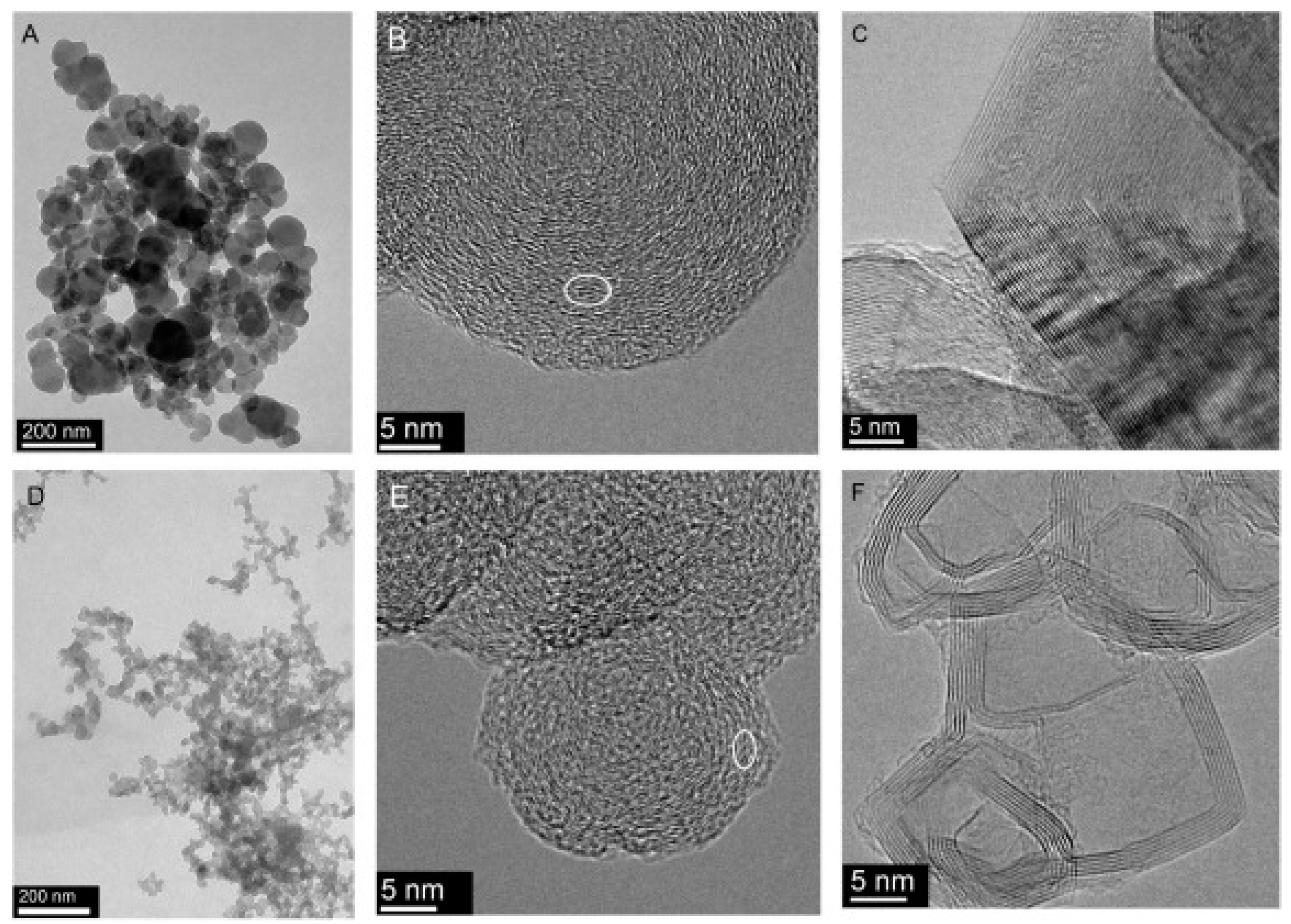
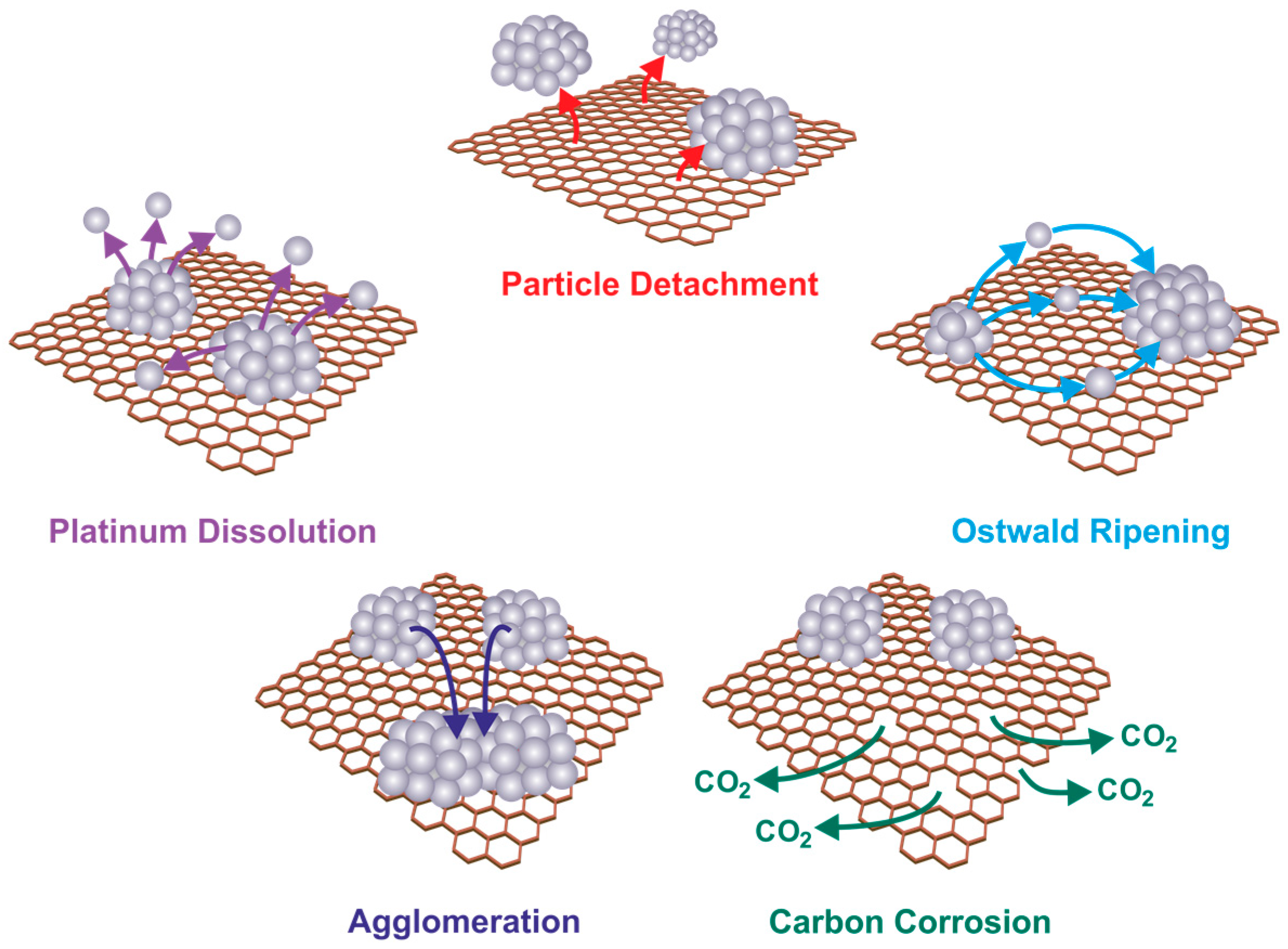
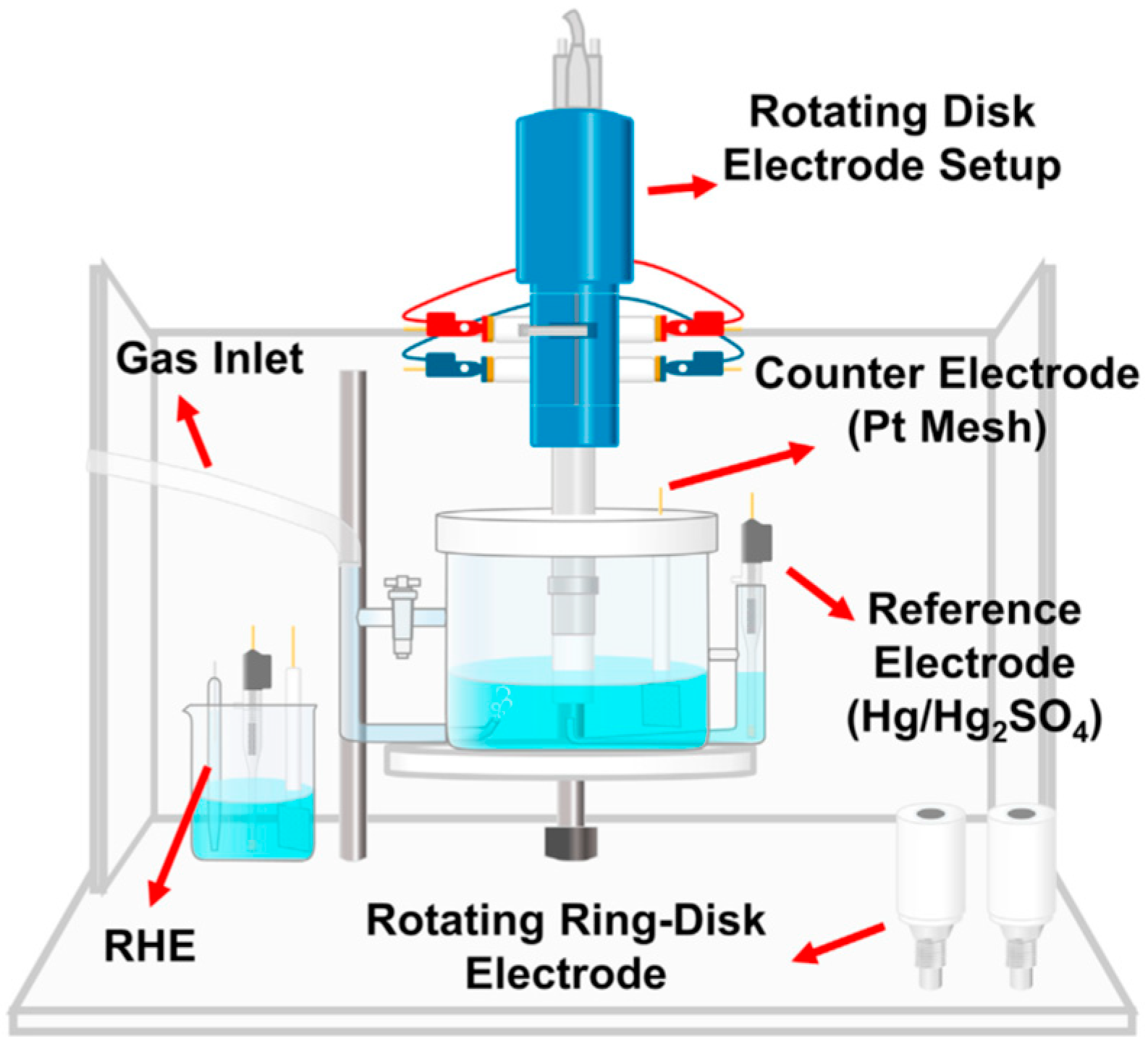
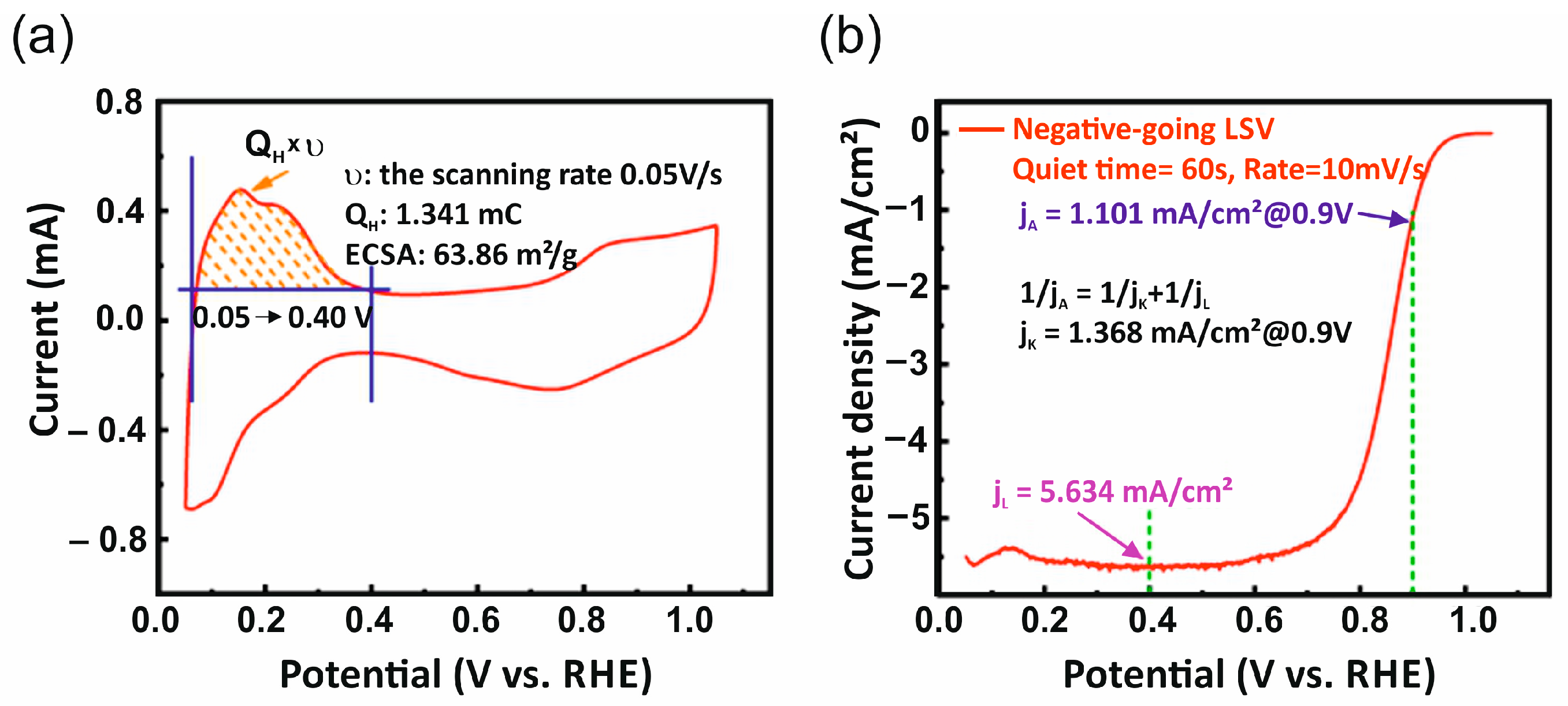
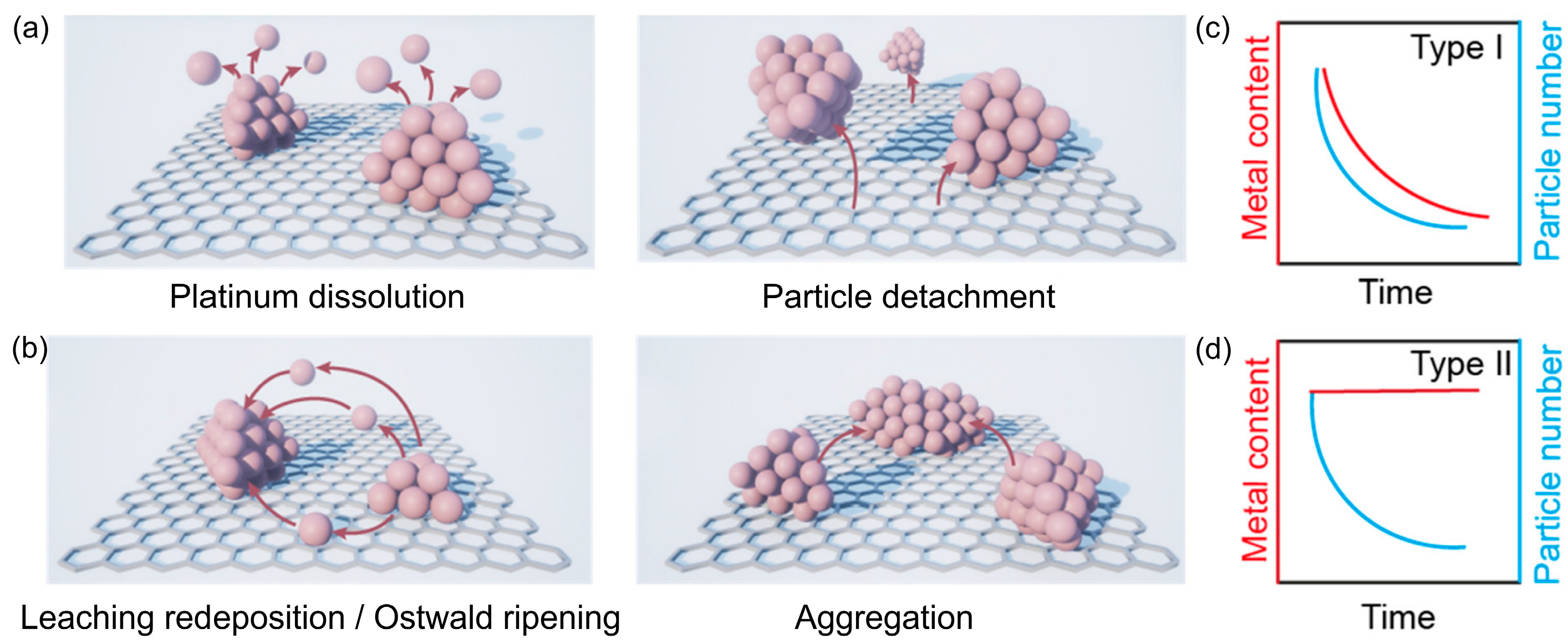

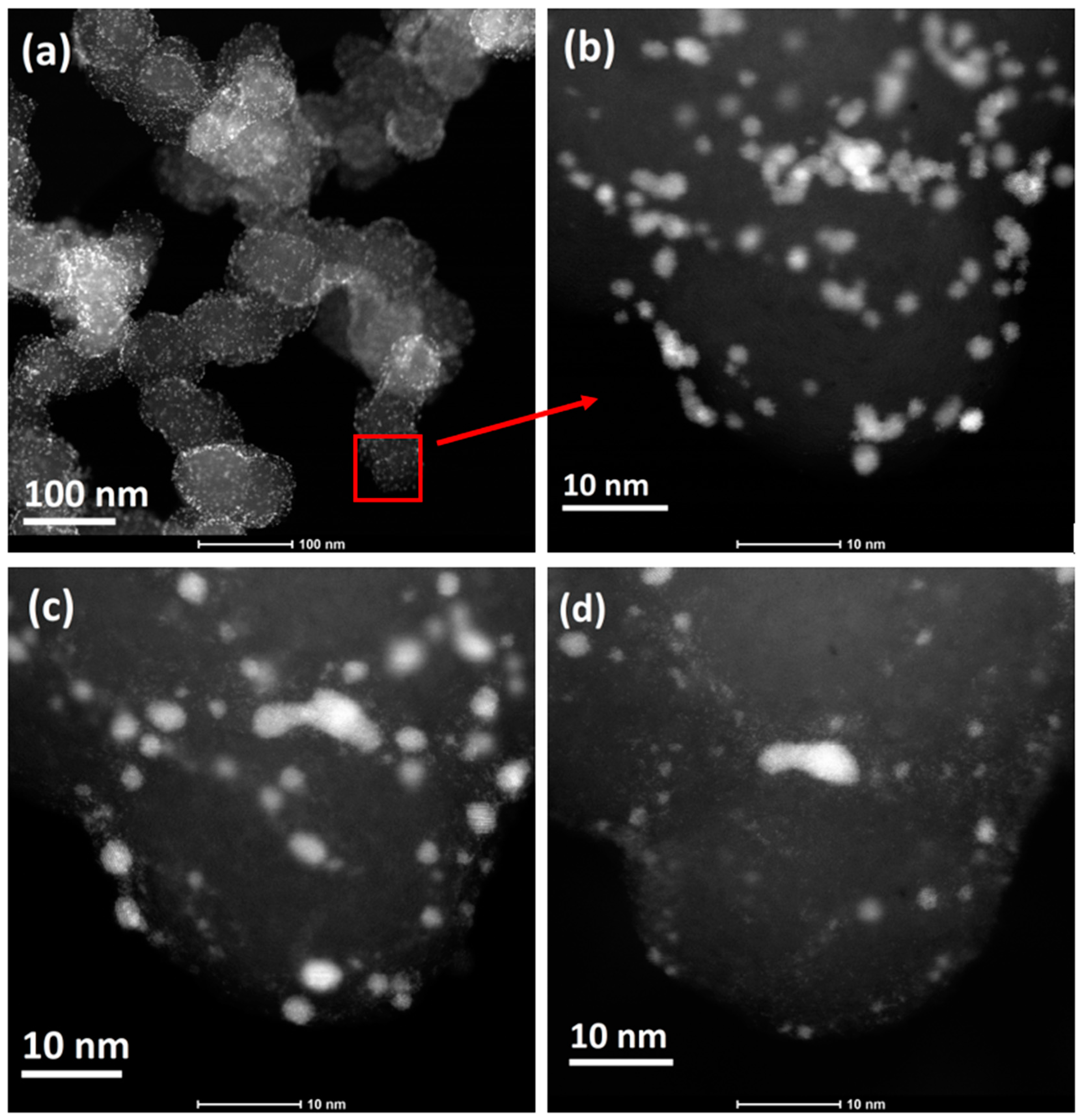
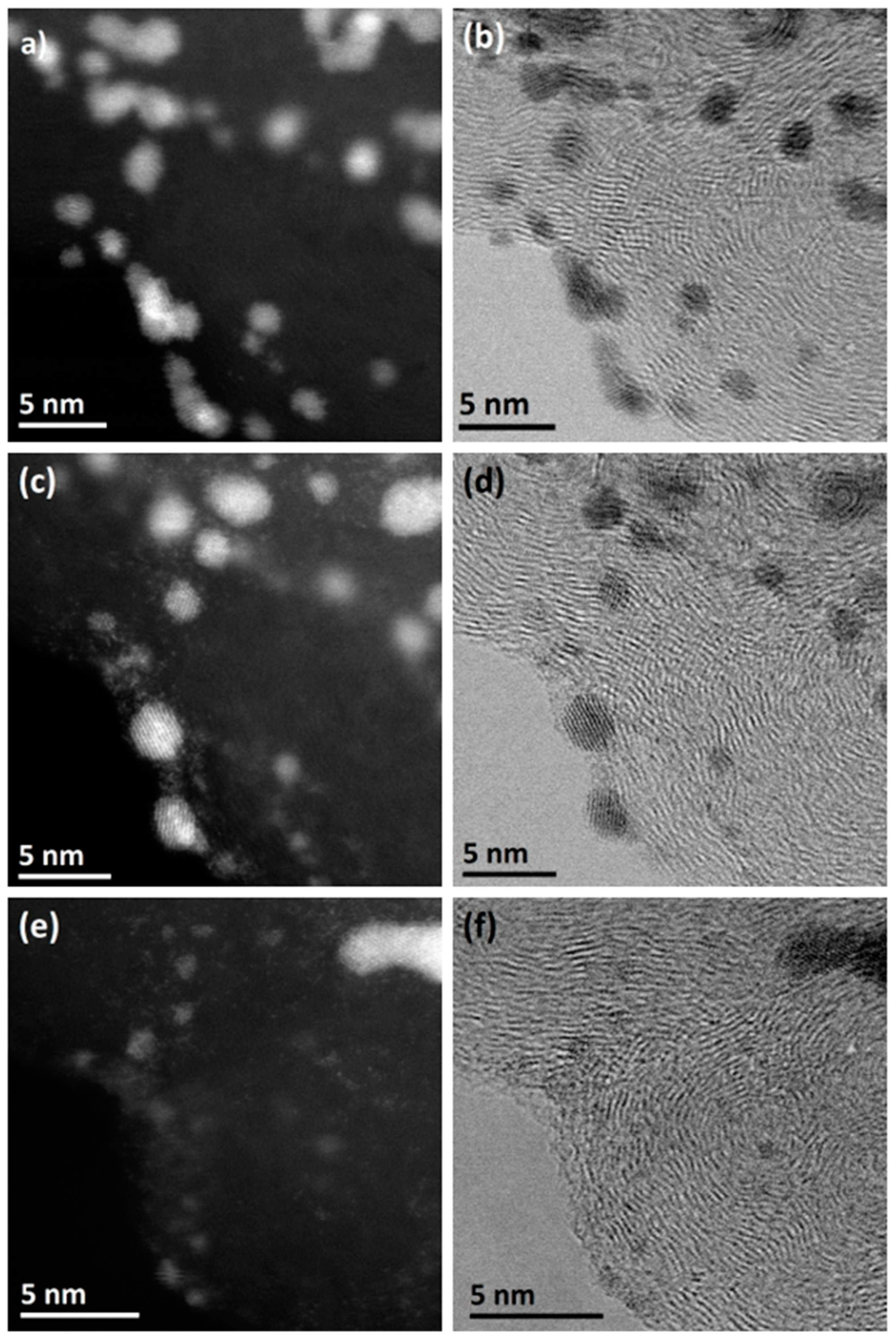
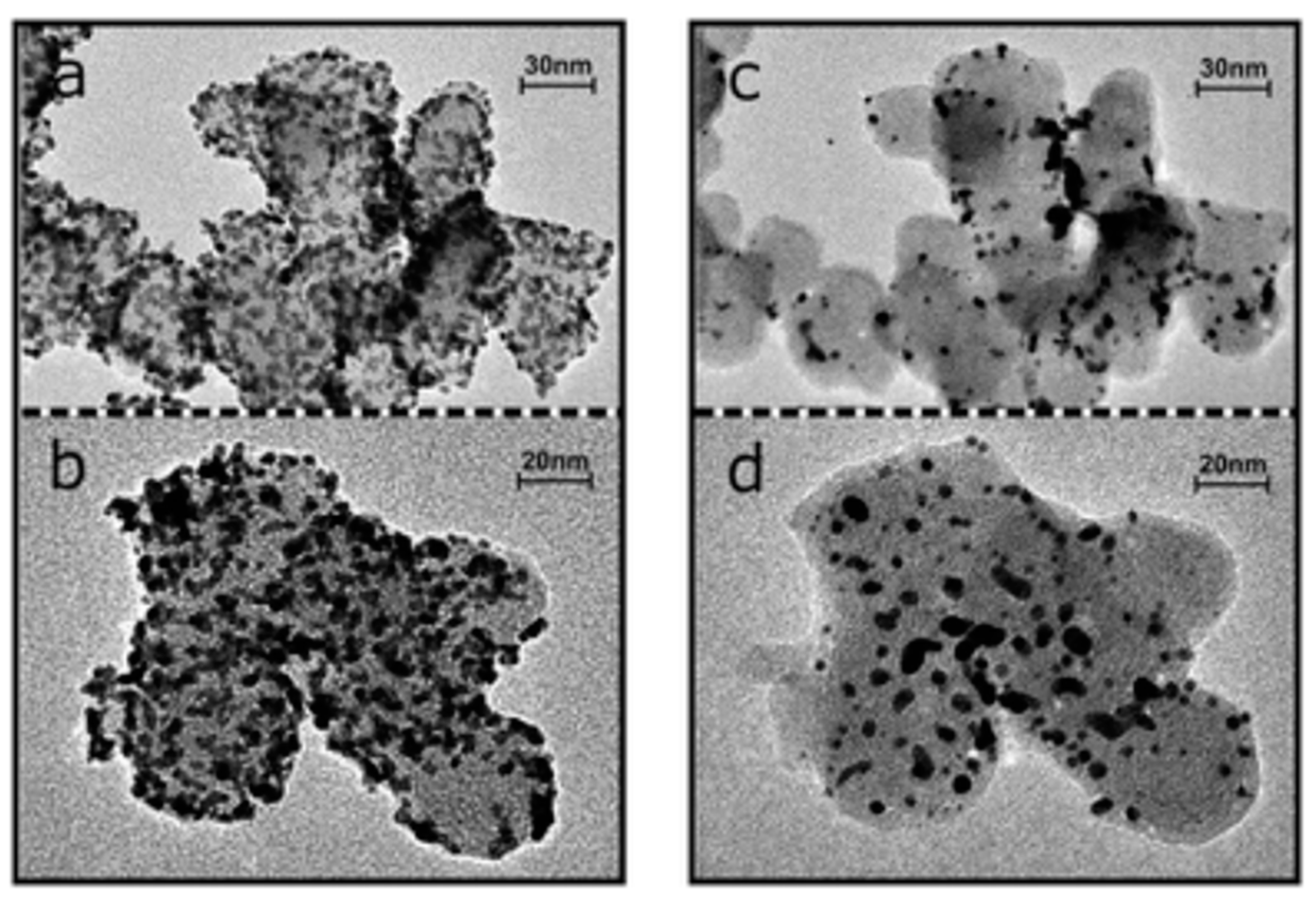

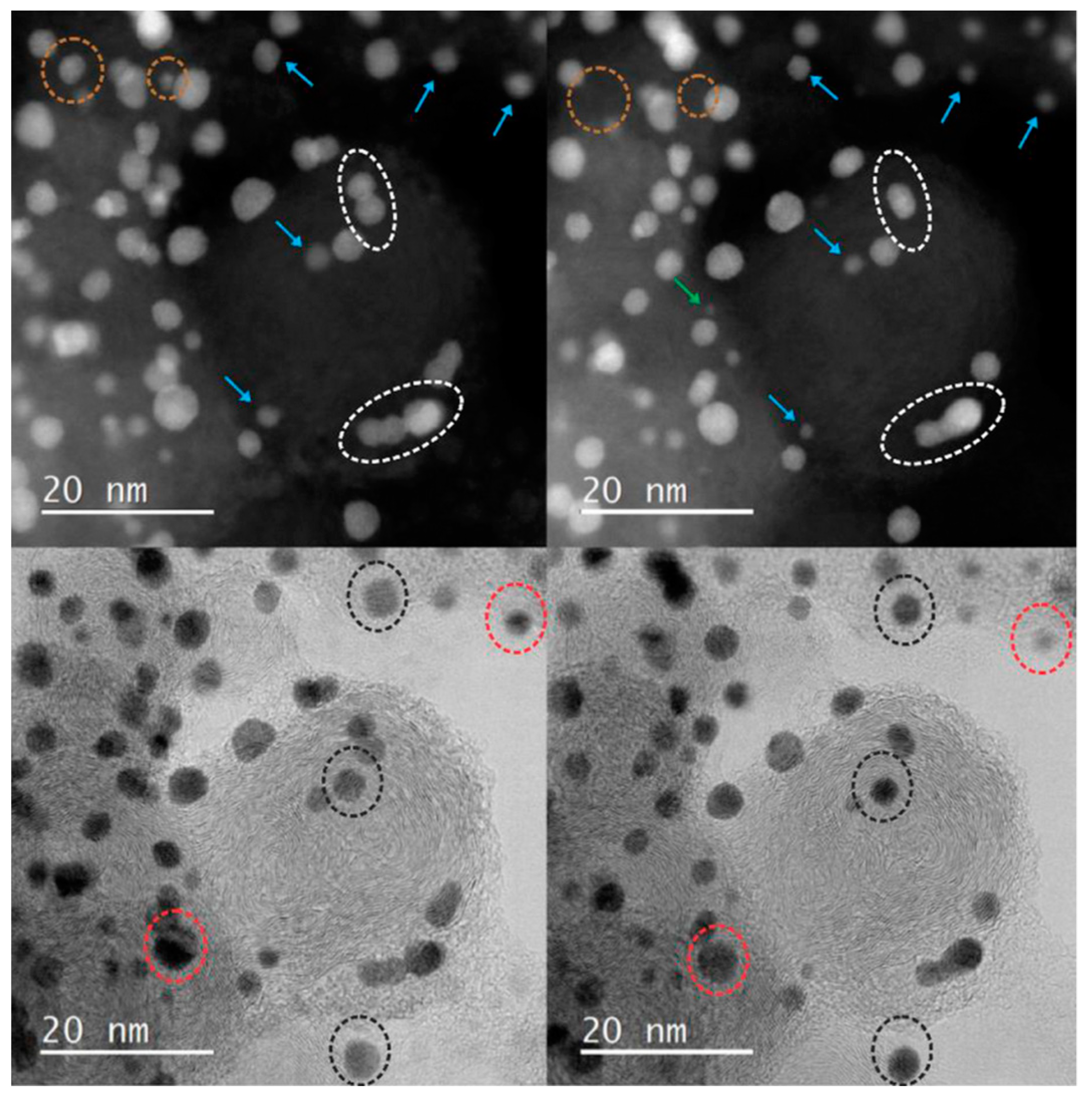
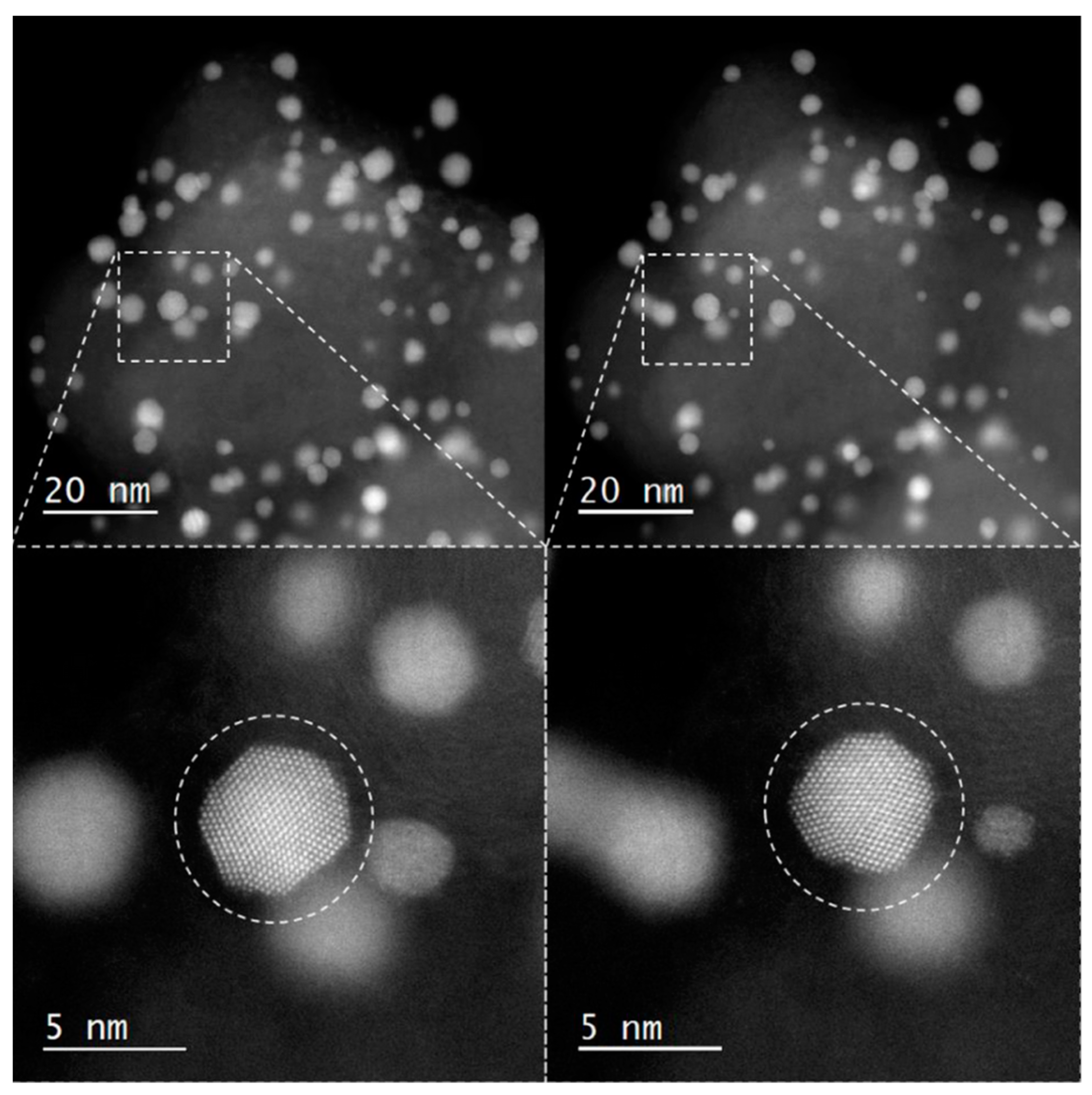
| Studies Focused on... | Investigated Catalyst | Results | Ref. |
|---|---|---|---|
| Size distributions, absolute number of nanoparticles, and corrosion of the carbon support | Pt/C; commercial (Tanaka Kikinzoku Kogyo K. K., Tokyo, Japan); loading of ~50 wt% Pt, particle diameter 5 nm | Degradation was observed when the sample was cycled to a high potential of 1.4 V (nanoparticle detachment). No degradation was observed when the upper potential was limited to 1.05 V or 1.2 V. There was a qualitative correlation with CO-stripping curves. | [69] |
| Degradation mechanisms of Pt nanoparticles deposited on carbon | Pt/C; produced in laboratory conditions; support: Carbon Black (Vulcan); 10 wt% Pt; particle diameter 2.5 nm | Catalyst degradation was observed (also for lower potential values). The degradation is mainly due to the dissolution of Pt with a minor contribution from sintering. The authors associated the increase in the dissolution fraction with the small size of the Pt catalyst nanoparticles. There was a qualitative correlation with electrochemical measurements of ORR activity. | [4] |
| The possibility of using IL-TEM for elevated electrolyte temperatures | Pt/C; commercial; loading of ~50 wt% Pt, particle diameter 5 nm | At elevated temperatures, the corrosion of the carbon support dominates the degradation of the catalyst. There was a qualitative correlation with ECSA loss. | [77] |
| The influence of the carbon support on catalyst degradation | Pt on various carbon supports (low- and high-surface-area carbon, modified by a transition metal); ~30 wt% Pt; particle diameter 3 nm | The improved properties of the catalyst with a transition-metal-modified support are due to the stabilization of the Pt particles attached to the support. Particle detachment can be drastically reduced, and the degradation is limited to a migration and coalescence or sintering mechanism. There was a qualitative correlation with ECSA loss. | [70] |
| Degradation mechanisms of Pt nanoparticles deposited on carbon | Pt and PtCo particles on different carbon supports (amorphous, graphitized); ~20–50 wt% Pt; particle diameter 2–5 nm | The main degradation channels are particle migration and coalescence, as well as particle detachment. No significant contribution of Pt dissolution was confirmed. Clear differences in the behavior of apparently similar catalysts during degradation were demonstrated (the great importance of the catalyst synthesis process). There was a qualitative correlation with ECSA loss. | [1] |
| Degradation mechanisms of Pt/C under simulated start/stop conditions | Pt/C; produced in laboratory conditions, support—Carbon Black (Vulcan); 20 wt% Pt; particle diameter 3.6 nm | Four different degradation paths were observed in one catalyst aggregate. Non-uniform degradation behavior was shown for different catalyst locations. There was a qualitative correlation with the real surface area loss. | [7] |
| Degradation mechanisms of Pt nanoparticles deposited on HSA carbon catalyst; investigation of the impact of different AST protocols | Pt/C; produced in laboratory conditions; support: Carbon Black (Ketjenblack EC300); 30 wt% Pt; particle diameter 2 nm | Under conditions simulating the load cycle, particle growth was mainly observed (by migration coalescence and by electrochemical Ostwald ripening). No particle detachment was observed. Under simulated start/stop conditions, particle detachment was activated as an additional degradation mechanism. There was a qualitative correlation with ECSA loss. | [78] |
| Degradation mechanisms of Pt/C in different potential ranges and under various gas atmospheres | Pt/C; commercial; support: Carbon Black (Vulcan); 40 wt% Pt; particle diameter 4.5 nm | The predominant degradation mechanism strongly depends on the nature of the gas atmosphere and of the upper potential limit used in accelerated stress tests. There was a qualitative correlation with ECSA loss. | [79] |
| Degradation mechanisms of Pt/C with various Pt loadings | Pt/C; produced in laboratory conditions; support: Carbon Blacks (Vulcan, Ketjenblack EC300); 30 wt% Pt; particle diameter 1.5–2 nm | Under conditions simulating the load cycle, no clear correlation was found between ECSA loss and the Pt:C ratio. Under conditions simulating start/stop conditions, the ECSA loss first increased with increasing Pt load and then decreased at very high loads. There was a qualitative correlation with ECSA loss. | [80] |
| Influence of the hydrogen evolution reaction overpotential on the mobility of Pt/C | Pt/C; commercial; particle diameter 3 nm | An increase in the number of migrating platinum particles with an increase in the overpotential value was revealed. Mechanisms have been revealed that may constitute a significant source of degradation. There was a qualitative correlation with ECSA loss. | [81] |
| Degradation mechanisms of Pt nanoparticles deposited on modified carbons | Pt/C modified by niobium pentoxide and tungsten carbide; produced in laboratory conditions; support: Carbon Black (Vulcan); ~20 wt% Pt; particle diameter 3–4 nm | Two phenomena leading to electrochemical surface area loss were detected: Pt particle growth and the loss of catalyst material, mainly due to the support’s degradation. There was a0 qualitative correlation with the relative surface area loss. | [82] |
| Experimental parameters to identify conditions that reproduce the degradation observed in MEAs | Pt and PtCo particles on various carbon supports; commercial; ~32 and 50 wt%; particle diameter 4–5 nm | By expanding the cyclic potential window, it is possible to better mimic the conditions typical of MEA measurements (the size distribution of degraded particles and the alloy composition better match those observed in MEA). | [76] |
| Degradation mechanisms of Pt/C, also on atomic scale | Pt/C; commercial; support: Carbon Black (Vulcan); 10 wt% Pt; particle diameter 1.5–2 nm | The degradation of the catalyst is mainly caused by the dissolution of Pt and the following secondary processes. The results suggest that the deposition of single Pt atoms on the carbon support is an important route, followed by dissolved Pt ions resulting from the dissolution of catalytic nanoparticles. There was a qualitative correlation with ECSA loss. | [5] |
| Degradation mechanisms of Pt/C using 3D tomography | Pt/C; commercial; support—Carbon Black (Vulcan); 5 wt% Pt; particle diameter 2 nm | The mechanism of particle migration followed by coalescence is shown to operate mainly over short distances (<0.5 nm). It is shown that new Pt particles appear on the carbon support as a result of Pt dissolution and then the formation of clusters that grow as a result of Ostwald ripening. | [9] |
| Quantification and visualization of Pt degradation mechanisms using correlative electron and X-ray imaging | Pt/C; commercial (Johnson Matthey Ltd., London, UK); 40 wt% Pt; particle diameter 2–5 nm. | Two types of mechanisms related to Pt degradation (with and without metal content changes) can be quantified. There was a qualitative correlation with ECSA loss. | [68] |
| Using iridium-coated microscopic grids (allow proper IL-TEM analysis of catalysts in durability tests without the interference of Au dissolution) | Pt/C; the alkylamine-modified Pt nanoparticle catalyst produced in laboratory conditions; support: Carbon Black (Vulcan); ~30 wt% Pt; particle diameter 2–3 nm. | It has been proven that the modification of the carbon support significantly increases the durability of the catalyst. There was a qualitative correlation with ECSA loss. | [83] |
| Feasibility of performing IL-TEM imaging in PEMFCs under real operating conditions (at the top of the catalytic Pt/C layer in a real PEMFC) | Pt/C; commercial; particle diameter 2–5 nm | Under conditions simulating the load cycle, Pt nanoparticles grow mainly as a result of Ostwald ripening, while the carbon support is stable. Under conditions simulating start/stop conditions, the carbon support degrades mainly through volume loss and collapse, which causes the Pt nanoparticles to approach each other, promoting additional particle growth. There was a qualitative correlation with ECSA loss. | [73] |
| AST protocol of potential cycles to represent the startup/shutdown settings of a fuel cell vehicle | Pt (2.3 nm) on CNT | Particle migration and coalescence are common mechanisms of Pt degradation in the early stages of the potential cycle. The mechanism of particle movement and coalescence is related to carbon corrosion, catalyzed either by Pt or by the bulk corrosion of carbon nanotubes. | [84] |
Disclaimer/Publisher’s Note: The statements, opinions and data contained in all publications are solely those of the individual author(s) and contributor(s) and not of MDPI and/or the editor(s). MDPI and/or the editor(s) disclaim responsibility for any injury to people or property resulting from any ideas, methods, instructions or products referred to in the content. |
© 2024 by the authors. Licensee MDPI, Basel, Switzerland. This article is an open access article distributed under the terms and conditions of the Creative Commons Attribution (CC BY) license (https://creativecommons.org/licenses/by/4.0/).
Share and Cite
Smykala, S.; Liszka, B.; Tomiczek, A.E.; Pawlyta, M. Using the IL-TEM Technique to Understand the Mechanism and Improve the Durability of Platinum Cathode Catalysts for Proton-Exchange Membrane Fuel Cells. Materials 2024, 17, 1384. https://doi.org/10.3390/ma17061384
Smykala S, Liszka B, Tomiczek AE, Pawlyta M. Using the IL-TEM Technique to Understand the Mechanism and Improve the Durability of Platinum Cathode Catalysts for Proton-Exchange Membrane Fuel Cells. Materials. 2024; 17(6):1384. https://doi.org/10.3390/ma17061384
Chicago/Turabian StyleSmykala, Szymon, Barbara Liszka, Anna E. Tomiczek, and Miroslawa Pawlyta. 2024. "Using the IL-TEM Technique to Understand the Mechanism and Improve the Durability of Platinum Cathode Catalysts for Proton-Exchange Membrane Fuel Cells" Materials 17, no. 6: 1384. https://doi.org/10.3390/ma17061384





